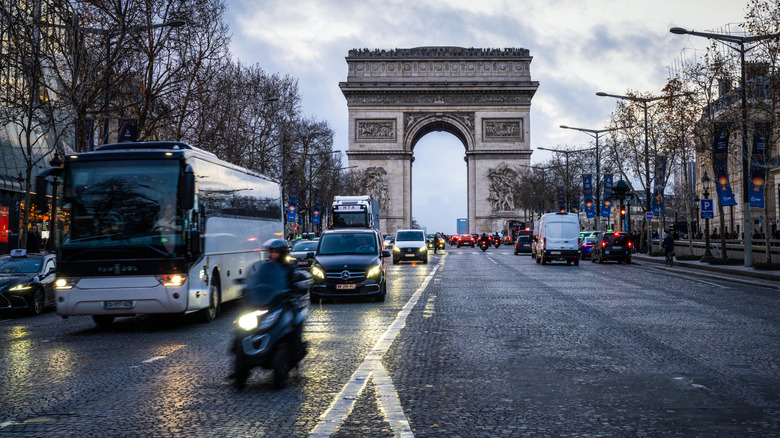Why You'll Probably Never See A Stop Sign In Paris
Paris is a dream destination full of gems to discover. The city has a lot to boast about, between the iconic Eiffel Tower, the staggering amount of art in its museums, and such curios as one of the world's oldest libraries and its impressive collection of books. But the one surprising thing Paris lacks entirely is a stop sign. That's right — the streets of Paris are stop-sign-free.
Tourists who've chosen to rent a car in Europe and drive in Paris for the first time will undoubtedly find the stop-sign-free intersections jarring. No, it's not an oversight. Parisians defer to the "priorité à droite" (priority to the right) rule: drivers on the left must give way to the car on the right at an intersection, unless stated otherwise. This right-of-way rule, deeply ingrained in Parisian driving culture, is the reason why you'll never see a stop sign in Paris.
While it sounds counterintuitive, the lack of stop signs makes drivers approach intersections with caution in anticipation of incoming cars, reducing the chances of severe road accidents. And it seems to be working: according to the data compiled by the Organization for Economic Cooperation and Development (OECD), the number of road accident injuries per 1 million inhabitants in France dropped 24% between 2010 and 2021; meanwhile, the data for the United States shows a 3.4% increase in such accidents during the same time period, despite its liberal use of stop signs.
How the stop sign disappeared from Paris's streets
In August 1954, France was the tenth country to ratify the United Nations' 1949 protocol on Road Signs and Signals, joining Belgium, Greece, Italy, Luxembourg, Monaco, and the Netherlands in a unified system of highway signalization. This meant that drivers encountered the same road signals and markings across European countries.
But because Parisian drivers operated by the right of way, the news of Paris' sole stop sign — published in the weekly newsletter of Paris' Police Prefecture in 2012 — became a sensation. So much so that the said stop sign, which stood minding its own business on a public road at the end of a private business property along the 16th arrondissement's Quai Saint-Exupéry, was stolen multiple times before finally disappearing for good the following year.
Outside Paris, though, stop signs do exist. The stop sign is still indicated in the French driving code, meaning you'll be obliged to mark a full stop should you encounter one. But the city is changing how visitors experience its streets. A majority of Parisians recently voted for a referendum that would ban cars from around 500 streets and remove 10,000 parking spots, according to Reuters. It seems like Parisians are sending out a message: You'd be better off taking the metro than dealing with the city's quirky road rules.

